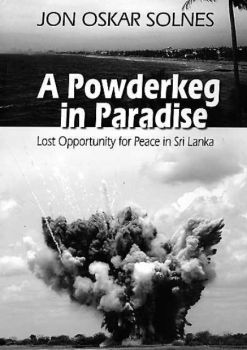 A POWDERKEG IN PARADISE - Lost Opportunity for Peace in Sri Lanka: Jon Oskar Solnes; Konark Publishers Pvt. Ltd., A-149, Main Vikas Marg, Delhi-110092. Rs. 750.
A POWDERKEG IN PARADISE - Lost Opportunity for Peace in Sri Lanka: Jon Oskar Solnes; Konark Publishers Pvt. Ltd., A-149, Main Vikas Marg, Delhi-110092. Rs. 750. Ilankai Tamil Sangam
Association of Tamils of Sri Lanka in the USA
Published by Sangam.org
Review by Nirupama Subramanian, The Hindu, August 17, 2010
|
Disappointingly for an “insider account”, there are no major revelations in the book; it is a faithful narrative of what is already in the public realm about the ceasefire and written carefully, striking a balance between the government and the LTTE, with the decisions/actions of both sides called into question. |
 A POWDERKEG IN PARADISE - Lost Opportunity for Peace in Sri Lanka: Jon Oskar Solnes; Konark Publishers Pvt. Ltd., A-149, Main Vikas Marg, Delhi-110092. Rs. 750.
A POWDERKEG IN PARADISE - Lost Opportunity for Peace in Sri Lanka: Jon Oskar Solnes; Konark Publishers Pvt. Ltd., A-149, Main Vikas Marg, Delhi-110092. Rs. 750.
Written by Jon Oskar Solnes, an Icelander who was chief of staff of the Sri Lanka Monitoring Mission that supervised the Norway brokered government-LTTE ceasefire, A Powderkeg in Paradise deals with an important phase in the conflict, discussing how the ceasefire broke down and set the stage for the LTTE's final defeat.
To those who knew that the ceasefire was built on a glaringly faulty premise — that the LTTE wanted a negotiated settlement within a united Sri Lanka — its eventual breakdown was foretold on the day it was signed. But Solnes, like many other western observers, does not see it that way. Hence the sub-title of the book: Lost Opportunity for Peace in Sri Lanka.
Disappointingly for an “insider account”, there are no major revelations in the book; it is a faithful narrative of what is already in the public realm about the ceasefire and written carefully, striking a balance between the government and the LTTE, with the decisions/actions of both sides called into question.
The author, however, provides a racy account of the happenings after the truce had effectively ceased to exist, starting with the suicide attack on Army Commander Sarath Fonseka in April 2006. The chapter that speaks about how the SLMM head of mission found himself at the receiving end of shelling by the Sri Lankan Army in Pooneryn, and the ceasefire monitors' rift with the government, makes interesting reading. Solnes asserts that the SLMM did not think of Ponneryn shelling as a deliberate attack. He also provides glimpses of the temperamental personality of Palitha Kohona, the head of the secretariat for the co-ordination of the peace process (now Sri Lanka's top diplomat at the United Nations), and the SLMM's rift with him.
It was a revelation of sorts, at least for this reviewer, that there were differences within the SLMM — made up of monitors from Nordic countries — on dealings with the government. Solnes also discloses that, as the ceasefire monitors were being projected as “white Tigers,” they feared attacks by Sinhalese extremists and so scrupulously avoided any open declaration of their affiliation with the SLMM. For all his interactions with the LTTE high command, Solnes reveals only snatches of those dealings — for example, that part of a conversation between Prabakaran and a visiting SLMM team in which the LTTE chief says while people called him a ‘ dictator', the description was more apt for his wife. Nevertheless, Solnes' factual account, in simple language, should be useful even to those researchers who would like to study the 2002 Ceasefire Agreement as a flawed model for conflict resolution.
© 1996-2025 Ilankai Tamil Sangam, USA, Inc.